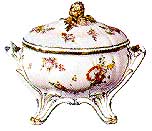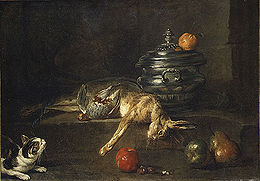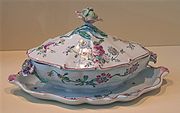
Tureen
Encyclopedia

Soup
Soup is a generally warm food that is made by combining ingredients such as meat and vegetables with stock, juice, water, or another liquid. Hot soups are additionally characterized by boiling solid ingredients in liquids in a pot until the flavors are extracted, forming a broth.Traditionally,...
s or stew
Stew
A stew is a combination of solid food ingredients that have been cooked in liquid and served in the resultant gravy. Ingredients in a stew can include any combination of vegetables , meat, especially tougher meats suitable for slow-cooking, such as beef. Poultry, sausages, and seafood are also used...
s, often shaped as a broad, deep, oval vessel with fixed handles and a low domed cover with a knob or handle. Over the centuries, tureens have appeared in many different forms, some round, rectangular, or made into fanciful shapes such as animals or wildfowl. Tureens may be ceramic—either the glazed earthenware
Earthenware
Earthenware is a common ceramic material, which is used extensively for pottery tableware and decorative objects.-Types of earthenware:Although body formulations vary between countries and even between individual makers, a generic composition is 25% ball clay, 28% kaolin, 32% quartz, and 15%...
called faience
Faience
Faience or faïence is the conventional name in English for fine tin-glazed pottery on a delicate pale buff earthenware body, originally associated with Faenza in northern Italy. The invention of a white pottery glaze suitable for painted decoration, by the addition of an oxide of tin to the slip...
or porcelain
Porcelain
Porcelain is a ceramic material made by heating raw materials, generally including clay in the form of kaolin, in a kiln to temperatures between and...
—or silver
Silversmith
A silversmith is a craftsperson who makes objects from silver or gold. The terms 'silversmith' and 'goldsmith' are not synonyms as the techniques, training, history, and guilds are or were largely the same but the end product varies greatly as does the scale of objects created.Silversmithing is the...
, and customarily they stand on an undertray or platter made en suite.
The tureen's prehistory may be traced to the use of the communal bowl, but during the reign of Louis XIV
Louis XIV of France
Louis XIV , known as Louis the Great or the Sun King , was a Bourbon monarch who ruled as King of France and Navarre. His reign, from 1643 to his death in 1715, began at the age of four and lasted seventy-two years, three months, and eighteen days...
it was developed from a practical covered serving vessel into one of the most richly ornamented centerpieces of the formal apparatus of dining. This period also saw the old practice of dressing the dinner table with every dish at once (service à la française
Service à la française
Service à la française is the practice of serving all the dishes of a meal at the same moment.This style prevailed in the courts of French royalty, as it made the greatest impression for all the delicacies of the kitchen to emerge simultaneously...
) superseded by the new practice of separate courses at meal time, each entrée
Entrée
An entrée is a dish served before the main course, or between two principal courses of a meal.The disappearance in the early 20th century of a large communal main course such as a roast as a standard part of the meal in the English-speaking world has led to the term being used to describe the main...
entering from the kitchens with an air of ceremony. Soup remained the first course of most meals, from the king's table to the peasant's, and the soup tureen on its serving platter provided the opening ceremony. Tureens naturally tended towards the impressive; the world's record auction price fetched for a single piece of silver was achieved by a silver tureen made in 1733 by the Parisian silversmith Thomas Germain
Thomas Germain
Thomas Germain was the pre-eminent Parisian silversmith of the Rococo.The son of a Paris silversmith Pierre Germain he did not at first train in the family workshop, but began as a painter, spending the years 1687–1702 in Rome, where he turned his hand towards goldsmith's work.Once again in Paris...
, sold at Sotheby's New York
Sotheby's
Sotheby's is the world's fourth oldest auction house in continuous operation.-History:The oldest auction house in operation is the Stockholms Auktionsverk founded in 1674, the second oldest is Göteborgs Auktionsverk founded in 1681 and third oldest being founded in 1731, all Swedish...
, 13 November 1996: at US$ 10,287,500 it tripled the former record.

Henri de la Tour d'Auvergne, Vicomte de Turenne
Henri de la Tour d'Auvergne, Vicomte de Turenne,often called simply Turenne was the most illustrious member of the La Tour d'Auvergne family. He achieved military fame and became a Marshal of France...
or called a pot à oille—a Catalan-Provençal soup— came into use in the later seventeenth-century France
France
The French Republic , The French Republic , The French Republic , (commonly known as France , is a unitary semi-presidential republic in Western Europe with several overseas territories and islands located on other continents and in the Indian, Pacific, and Atlantic oceans. Metropolitan France...
. An alternative explanation for the origin of the English word tureen is that it is related to the earlier word terrine, a borrowing from the French for 'a large, circular, earthenware dish'.
Most seventeenth-century silver tureens were melted down to finance the wars of Louis' late years and may be glimpsed only in paintings. The ornate silver tureens of that period figure in buffets—still life of silver and game—by artists such as Alexandre-François Desportes
Alexandre-François Desportes
Alexandre-François Desportes was a French painter and decorative designer who specialised in animals.Desportes was born in Champigneul, Marne. He studied in Paris, in the studio of the Flemish painter Nicasius Bernaerts, a pupil of Frans Snyders...
, or in more modest still life
Still life
A still life is a work of art depicting mostly inanimate subject matter, typically commonplace objects which may be either natural or man-made...
, such as the painting by Jean-Baptiste-Siméon Chardin
Jean-Baptiste-Siméon Chardin
Jean-Baptiste-Siméon Chardin was an 18th-century French painter. He is considered a master of still life, and is also noted for his genre paintings which depict kitchen maids, children, and domestic activities...
(illustration), which is dated 1728 but depicts a silver tureen of Baroque
Baroque
The Baroque is a period and the style that used exaggerated motion and clear, easily interpreted detail to produce drama, tension, exuberance, and grandeur in sculpture, painting, literature, dance, and music...
form of the first decade of the century. During the mid-eighteenth century, tureens in appropriate naturalistic shapes, such as tureens in the form of a head of cabbage, were popular. The Chelsea porcelain manufactory produced tureens in the form of rabbits: a Chelsea sale catalogue of 1755 advertised a "Fine tureen in the form of a rabbit as big as life."

John T. Dorrance, a member of the family owners of Campbell's Soup, assembled, starting in 1966, the largest representative collection of soup tureens, which has been donated to the Henry Francis DuPont Winterthur Museum
Henry Francis DuPont Winterthur Museum
Winterthur Museum and Country Estate is an American estate and museum in Winterthur, Delaware. it houses one of the most important collections of Americana in the United States of America. It was the former home of Henry Francis du Pont , a renowned antiques collector and horticulturist...
.
In pop culture
- The song Present Tense Tureen is on the Moxy FruvousMoxy FrüvousMoxy Früvous was a politically satirical folk-pop band from Thornhill, Ontario, Canada. The band was founded in 1989, and was active throughout the 1990s...
album WoodWood (album)Wood was the 1995 second studio album by Canadian artists Moxy Früvous.-Track listing:#"Down from Above" – 4:34#"Horseshoes" – 3:57#"Fly" – 4:57#"The Present Tense Tureen" – 3:38#"Poor Mary Lane" – 3:28#"On Her Doorstep" – 3:22...
. - On Wienerville one of host Mark WienerMark WienerMark Wiener is a New York-based abstract painter, editor, teacher.Wiener studied painting and photography under Bauhaus influences at the Philadelphia College of Art. Influenced by Alexi Brodivitch, Frank Zachry and Alexander Lieberman, he early began working simultaneously in several visual media...
's puppet alter-egos was "Soup Tureen", a smarmy game showGame showA game show is a type of radio or television program in which members of the public, television personalities or celebrities, sometimes as part of a team, play a game which involves answering questions or solving puzzles usually for money and/or prizes...
host.

